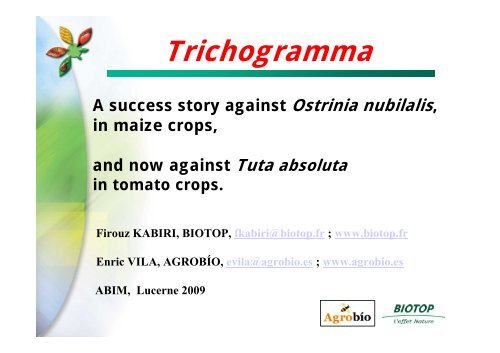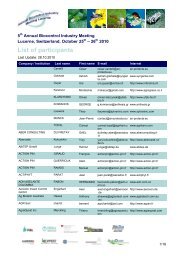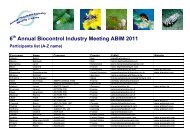a success story in corn fields against Ostrinia nubilalis, and now in ...
a success story in corn fields against Ostrinia nubilalis, and now in ...
a success story in corn fields against Ostrinia nubilalis, and now in ...
Create successful ePaper yourself
Turn your PDF publications into a flip-book with our unique Google optimized e-Paper software.
Trichogramma<br />
A <strong>success</strong> <strong>story</strong> aga<strong>in</strong>st Ostr<strong>in</strong>ia <strong>nubilalis</strong>,<br />
<strong>in</strong> maize crops,<br />
<strong>and</strong> <strong>now</strong> aga<strong>in</strong>st Tuta absoluta<br />
<strong>in</strong> tomato crops.<br />
Firouz KABIRI, BIOTOP, fkabiri@biotop.fr ; www.biotop.fr<br />
Enric VILA, AGROBÍO, evila@agrobio.es ; www.agrobio.es<br />
ABIM, Lucerne 2009
BIOTOP: Sub company of Invivo Group <strong>in</strong> France<br />
Involved <strong>in</strong> R&D, production <strong>and</strong> commercialization of<br />
products for alternative plant protection methods,<br />
• 1975: beg<strong>in</strong>n<strong>in</strong>g of researches, with INRA,<br />
on Trichogramma aga<strong>in</strong>st the ECB<br />
• 1985: commercialization of T. brassicae<br />
Products:<br />
‣ Trichogramma: T. brassicae, T.achaeae, T. evanescens.<br />
‣ Ladybirds: H. axyridis, A. bipunctata.<br />
‣ Other predators: Macrolophus, Orius, Anthocoris, …<br />
‣ Pheromone, traps, Bt, … : Ecopom, Mastrap, Vectobac DT,
Trichogramma (Micro-Hymenoptera ;
Trichogramma : a perform<strong>in</strong>g beneficial<br />
Very well adapted for large scale utilization, with<br />
massive releases <strong>and</strong> costs comparable to<br />
chemical <strong>in</strong>secticides<br />
T. brassicae aga<strong>in</strong>st the ECB :<br />
‣ Used every year on more than 100 000ha<br />
<strong>in</strong> France, Germany, Switzerl<strong>and</strong>, Czech<br />
Republic<br />
‣ Ma<strong>in</strong>ly with just one release / season<br />
‣ A technical <strong>and</strong> commercial <strong>success</strong>
TRICHOGRAMMA AGAINST ECB IN FRANCE<br />
Technical evolutions <strong>in</strong> Biotop’s system<br />
Capsules spread on soil <strong>and</strong> then hung on plant with cones<br />
New patented<br />
Dispenser (2003)
TRICHOGRAMMA AGAINST ECB IN FRANCE<br />
Simplified <strong>and</strong> improved progressively :<br />
1985 3 releases, Trichogramma <strong>in</strong> capsules on soil,<br />
1992 2 releases, capsules on soil or plants,<br />
1996 1 release, capsules on plants,<br />
2003 new dispenser, on plants,<br />
2005 <strong>in</strong>creased persistence of action
TRICHOGRAMMA / ECB IN FRANCE<br />
1000 ha<br />
MORE THAN 20 YEARS FOR A SUCCESS STORY<br />
100<br />
90<br />
80<br />
70<br />
RESEARCH<br />
EXPERIMENTATIONS<br />
OPTIMIZATIONS<br />
3 RELEASES<br />
1 RELEASE<br />
ONE RELEASE<br />
60<br />
50<br />
40<br />
30<br />
20<br />
10<br />
0<br />
75 76 77 78 79 80 81 82 83 84 85 86 87 88 89 90 91 92 93 94 95 96 97 98 99 0 1 2 3 4<br />
1975 85 95<br />
2005
A new Trichogramma development<br />
‣ T. achaeae an excellent agent<br />
<strong>now</strong> <strong>in</strong> development aga<strong>in</strong>st Tuta absoluta<br />
(Enric Vila)<br />
‣ important po<strong>in</strong>ts to develop Trichogramma project<br />
<strong>and</strong> future steps with T. achaeae on Tuta<br />
(Firouz Kabiri)
Tuta absoluta: accidentally <strong>in</strong>troduced <strong>in</strong> Spa<strong>in</strong> <strong>in</strong> 2007<br />
It spread very fast throughout Spa<strong>in</strong>, also <strong>in</strong> Europe<br />
(France, Italy, Holl<strong>and</strong>, Switzerl<strong>and</strong>, …)) <strong>and</strong> North Africa<br />
(Algeria, Morocco…).<br />
Nowadays, a big social warn<strong>in</strong>g due to:<br />
‣Important damages on tomato <strong>and</strong> other Solanaceae crops.<br />
‣Problems to export.
Established <strong>in</strong> 1995
Research Department<br />
Technical-commercial<br />
commercial<br />
Total 105 persons<br />
Production
Work Areas<br />
1.- Bumblebees<br />
2.- Beneficial <strong>in</strong>sects
Cosmopolitan specie (<strong>now</strong>adays, identified <strong>in</strong> 11 countries)<br />
Distribution:<br />
Europe: Spa<strong>in</strong>, Russia.<br />
Asia: Ch<strong>in</strong>a, India, Russia.<br />
Africa: Cape Verde.<br />
America: Argent<strong>in</strong>a, Barbados, Chile, Tr<strong>in</strong>idad & Tobago, USA.<br />
Female<br />
438,27‐408,7 μm<br />
(< 0,5 mm)
Trials <strong>and</strong> Results<br />
2007: Biology of Trichogramma <strong>in</strong> lab conditions (UAL).<br />
2008/09:<br />
• 4 Semifield trials (R&D facilities of Agrobío).<br />
(Published on IOBC/wprs Bullet<strong>in</strong> Vol. 49, 2009)<br />
• Trials <strong>in</strong> experimental greenhouse. February‐ May.<br />
• Trials with T. achaeae <strong>in</strong> 20 commercial greenhouses.
Results<br />
Evolution of Tuta absoluta 62 DAYS after releases <strong>in</strong><br />
experimental greenhouses (second generation)<br />
87.7<br />
EFFICACY OF METHOD<br />
95,82%<br />
EFFICACY OF METHOD<br />
Comb<strong>in</strong>ed action<br />
95,82% 33.3<br />
28.6<br />
Comb<strong>in</strong>ed action<br />
0<br />
31.8 34.7<br />
0 % fruits<br />
damaged<br />
18.9 % fruits<br />
damaged<br />
1.3 1.4<br />
T. achaeae + N. tenuis N. tenuis
Results<br />
STARTING 3rd GENERATION (T+75 days)<br />
WITH T. achaeae<br />
WITHOUT
Conclusions of this trial<br />
►The only use of Nesidiocoris tenuis is not enough<br />
to control the pest.<br />
►The comb<strong>in</strong>ed use of both natural enemies gave an<br />
excellent result (efficacy 95,8 %).<br />
► The native specie T. achaeae is very effective,<br />
more than natural enemies of Tuta <strong>in</strong> its orig<strong>in</strong>al<br />
area (Southamerica)
Trials of T. achaeae <strong>in</strong> commercial greenhouses<br />
- June- August 2009 (most <strong>in</strong> course).<br />
- 20 greenhouses on different areas.<br />
- 90 % have a good control of the pest after 3 months<br />
without any chemical treatment aga<strong>in</strong>st Tuta.
Trichogramma achaeae aga<strong>in</strong>st Tuta absoluta<br />
After the very good results <strong>in</strong> trials, the<br />
recommendation for use is based on:<br />
a) Prevention <strong>and</strong> monitor<strong>in</strong>g (clean<strong>in</strong>g<br />
soil, physical barriers, trapp<strong>in</strong>g, …).<br />
b) Early releases (as soon as the first adult<br />
of Tuta is captured) <strong>in</strong> order to start the<br />
control on the first generations of the pest.<br />
c) Release 250 000 – 1000,000 T/ha/week.<br />
d) Comb<strong>in</strong>ation with mirid predators<br />
(N. tenuis, M. calig<strong>in</strong>osus).<br />
Patented dispenser:<br />
performant, easy to use<br />
e) weekly sampl<strong>in</strong>g method, to adapt release<br />
rate <strong>and</strong> to apply Bt if needed.
New <strong>success</strong> <strong>story</strong> with Trichogramma<br />
- F<strong>in</strong>d a good beneficial: T. achaeae is very well adapted<br />
to warm conditions, <strong>and</strong> also with low environmental risk<br />
(can not overw<strong>in</strong>ter <strong>in</strong> the South of France),<br />
- large production capacity: availability of the host<br />
Ephestia kuehniella <strong>and</strong> of the k<strong>now</strong> how on rear<strong>in</strong>g <strong>and</strong><br />
pack<strong>in</strong>g of the beneficial,<br />
- quality control policy,<br />
- field trials,
Quality Control, the base for<br />
underst<strong>and</strong><strong>in</strong>g <strong>and</strong> improv<strong>in</strong>g the system<br />
Controls: rear<strong>in</strong>g, quality of the product <strong>and</strong> field efficacy<br />
100,0%<br />
ECB parasitized eggmasses<br />
90,0%<br />
80,0%<br />
70,0%<br />
60,0%<br />
50,0%<br />
40,0%<br />
30,0%<br />
20,0%<br />
10,0%<br />
0,0%<br />
03 26 31 09 63 01 34 32 67 26 47 72 67 67 26 09<br />
(G2)<br />
(G2) (G2) (G2) (G2) (G2) (G2) (G2) (G1) (G2) (G2) (G1) (G1) (G1) (G2) (G2)<br />
1997 1998 2000 2001 2002 2004 2005 2006 2007 2008 2009
Trichogramma aga<strong>in</strong>st ECB:<br />
adaptation to the pest <strong>and</strong> crops<br />
ECB<br />
crop<br />
ECB risk<br />
Number<br />
of<br />
Release<br />
Number of<br />
dispenser/<br />
ha<br />
Number of<br />
Tricho/ha<br />
(X1000)<br />
1st<br />
Genera<br />
tion<br />
Gra<strong>in</strong>,<br />
seed <strong>and</strong><br />
silage <strong>corn</strong><br />
Sweet<br />
<strong>corn</strong><br />
Low<br />
Medium<br />
High<br />
All<br />
situations<br />
1<br />
1<br />
2<br />
2<br />
25<br />
25<br />
25 + 25<br />
25 + 25<br />
150<br />
225<br />
225<br />
+ 150 375<br />
225<br />
+ 150 375<br />
Gra<strong>in</strong> <strong>and</strong><br />
seed <strong>corn</strong><br />
Low<br />
Medium<br />
1<br />
1<br />
50<br />
50<br />
300<br />
375<br />
2 nd<br />
Genera<br />
tion<br />
Sweet<br />
<strong>corn</strong> <strong>and</strong><br />
Field<br />
pepper<br />
High<br />
All<br />
situations<br />
2<br />
2<br />
50 + 50<br />
50 + 50<br />
375<br />
+ 225 600<br />
375<br />
+ 225 600
T. achaeae: current experimentations<br />
Laboratory <strong>and</strong> field experimentations to improve <strong>and</strong> facilitate<br />
the method, ma<strong>in</strong>ly:<br />
- Delayed hatch<strong>in</strong>g Trichogramma to reduce release number,<br />
- Storage possibilities (T. brassicae can be stored several months)<br />
- Study dispersion methods adapted to different crop situation,<br />
- Improve the k<strong>now</strong>ledge on Tuta biology for better <strong>in</strong>tegrat<strong>in</strong>g<br />
T.achaeae, Mirids, Bt <strong>and</strong> chemicals,<br />
- study side effect of chemicals <strong>in</strong> order to help farmers to switch<br />
to IPM (sometimes dur<strong>in</strong>g the season, after failure of chemicals)
Trichogramma <strong>and</strong><br />
reduction of chemicals use<br />
‣ Chemicals are difficult to use aga<strong>in</strong>st Tuta:<br />
larvae <strong>in</strong> m<strong>in</strong>es, overlapp<strong>in</strong>g generations all over the<br />
season, risk of resistance, … (<strong>in</strong> Spa<strong>in</strong>, Sp<strong>in</strong>ozade usable<br />
only 3 times/season <strong>in</strong> order to prevent resistance)<br />
‣ Necessity to comb<strong>in</strong>e chemicals <strong>and</strong> beneficials:<br />
better pest <strong>and</strong> resistance management <strong>in</strong> order to<br />
reduce the use of chemicals <strong>and</strong> also to save their efficacy<br />
when their help is needed.
T. achaeae: next steps<br />
International research to develop T. achaeae <strong>in</strong><br />
different countries <strong>in</strong> greenhouses:<br />
- Check performance <strong>in</strong> different Tuta extend<strong>in</strong>g areas.<br />
- Develop a protocol accord<strong>in</strong>g to conditions <strong>in</strong> each<br />
area.<br />
Also develop trials for outdoor tomato productions
Public / Private cooperation<br />
• Success aga<strong>in</strong>st ECB: thanks to close cooperation<br />
between Biotop <strong>and</strong> INRA,<br />
• Very promis<strong>in</strong>g project on Tuta: thanks to close<br />
cooperation between Biotop, Agrobío <strong>and</strong><br />
University of Almería,<br />
‣ And <strong>now</strong> new cooperations start with:<br />
- INRA (ULB-URIH <strong>in</strong> Sophia Antipolis)<br />
- other research <strong>in</strong>stitutes <strong>and</strong> partners<br />
‣ It is necessary to promote public/private cooperations,<br />
for quick <strong>and</strong> large development of IPM.
THANK YOU FOR YOUR ATTENTION<br />
For more <strong>in</strong>formation<br />
contact:<br />
Enric Vila from Agrobío<br />
evila@agrobio.es<br />
or<br />
Firouz Kabiri from Biotop<br />
fkabiri@biotop.fr











